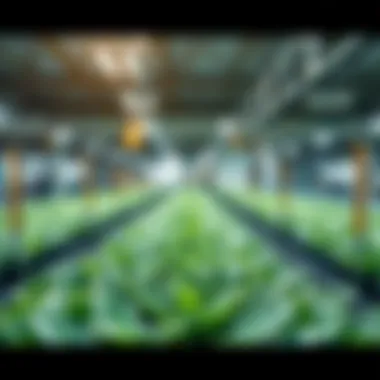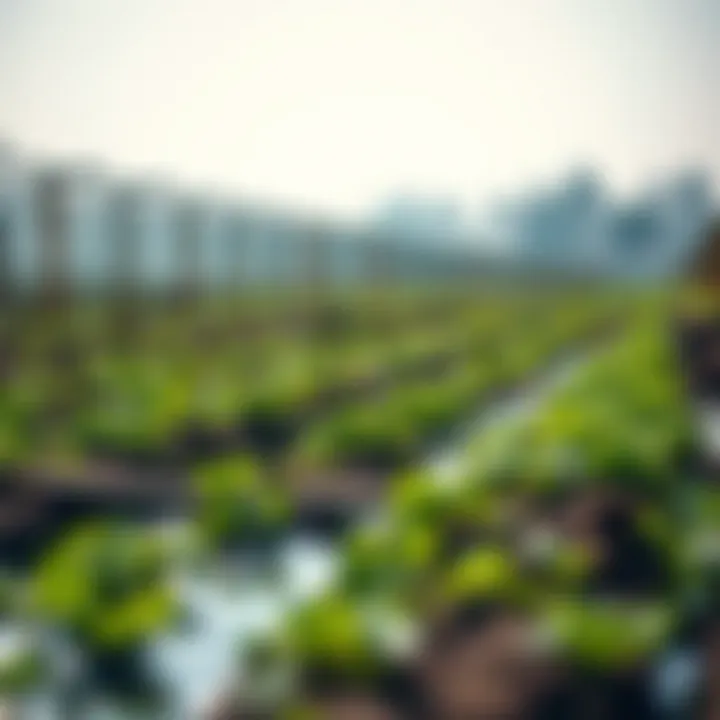Innovative Green Technologies in Food Processing


Key Concepts and Terminology
Understanding green technology in food processing begins with grasping its core concepts and terminology. The field revolves around integrating sustainable practices into food manufacturing to promote environmental responsibility and efficiency.
Basic Definitions
At its heart, green technology refers to products, services, and processes that are designed with sustainability in mind. This includes technologies that enhance operational performance while minimizing environmental impact. Key terms include:
- Sustainability: The ability to maintain or improve processes without depleting resources or harming ecological systems.
- Waste Reduction: Strategies aimed at decreasing the volume or toxicity of waste generated by food processing activities.
- Energy Conservation: Methods of reducing energy consumption while maintaining output levels.
Understanding these definitions lays the foundation for further exploration into how such technologies are implemented within the food processing industry.
Historical Context
Historically, food processing has been driven by demand for efficiency and cost-effectiveness. However, the growing consciousness about environmental issues has shifted priorities. Not long ago, factors such as profit margins and production speed overshadowed ecological considerations. Traditional methods often led to considerable waste and energy consumption.
The late 20th century brought about a change in perspective, with the emergence of the sustainability movement. As consumers began to demand environmentally friendly products, the industry had to adapt. Companies started re-evaluating their practices, leading to an increased emphasis on reducing waste and conserving energy.
This shift was not merely a trend; it has become an essential consideration for survival in a market increasingly favoring eco-conscious operators.
"Adopting green technology is no longer an option; it's a necessity for businesses wishing to remain relevant."
Recent Innovations and Trends
Staying current with advancements is vital for those involved in the food processing industry. This section dives into some of the latest innovations that are shaping the future of sustainable food production.
Technological Advancements
Recent years have seen a surge in technology tailored for sustainability. Innovations include:
- Biotechnology: Techniques such as fermentation use microorganisms to produce food with less energy and waste.
- Solar Energy: This renewable resource is increasingly utilized to power processing plants, reducing reliance on fossil fuels.
- Smart technology: IoT (Internet of Things) systems optimize resource usage, monitor waste, and enhance energy efficiency.
Sustainable Practices
Moreover, sustainable practices are taking root across operations. Techniques such as:
- Vertical Farming: Growing food in stacked layers aims to minimize land use while maximizing yield.
- Decentralized Processing: Localized production reduces transportation emissions and employs local resources, allowing for fresher products and reduced spoilage.
The convergence of these trends not only improves business efficiency but also appeals to a growing customer base that values sustainability.
Practical Applications and Techniques
With the groundwork laid, it’s crucial to discuss how these concepts materialize in real-world practices. Below are some methods and case studies demonstrating the application of green technology.
Step-by-step Guides
To successfully implement green technology, food processors can follow these steps:
- Conduct an Audit: Evaluate current energy and waste metrics to identify areas for improvement.
- Research Technologies: Investigate available solutions that match the needs identified in the audit.
- Pilot Testing: Begin with small-scale implementation of technology and monitor results.
- Scale Up: Based on pilot success, expand the use of technology across operations.
- Engage Stakeholders: Involve employees and suppliers in the transition to ensure organization-wide support.
Case Studies
Examining tangible examples can clarify the positive impacts of green technology. For instance, a manufacturer like Nestlé has invested significantly into sustainability by implementing water conservation strategies across its factories. Reports indicate that these measures have resulted in a substantial decrease in water usage, allowing for better resource management.
Additionally, PepsiCo has begun utilizing energy-efficient technologies, which led to a reduction in their carbon footprint. Such initiatives not only showcase the feasibility of green approaches but also offer practical templates for others looking to embrace sustainability in food processing.
As the food processing landscape evolves, understanding these concepts and applications will be critical for anyone aiming to thrive in a more environmentally aware market.
Relevant resources include Wikipedia and Britannica.
Stay tuned as we delve deeper into individual technologies and their specific applications within the green technology framework in future sections.
Prelims to Green Technology in Food Processing
The intersection of technology and agriculture has always held great significance, but as we stare down the barrel of climate change, the focus sharpens even further on sustainability, especially in the food processing sector. Green technology is not just a trend; it represents a fundamental shift towards methods that promise not only productivity but also responsible stewardship of our planet’s resources. The introduction of eco-friendly practices aims to reduce environmental hazards and ensures that we are not just feeding current generations but also safeguarding food supplies for the future.
Often, the conversation centers around immediate benefits like cost savings and productivity gains, but the nuances of green technology extend well beyond these metrics. For manufacturers in the food sector, adopting sustainable practices means examining every facet of operations—from resource use and waste management to energy consumption. It's about finding smarter ways to operate, which often leads to long-term savings and broader market appeal. The modern consumer is becoming increasingly savvy, favoring products that align with their values of sustainability and health.
In this section, we’ll define what green technology encompasses within food processing and delve into why embracing sustainability carries immense importance.
Defining Green Technology
Green technology refers to a broad range of methods, systems, and processes aimed at contributing to sustainable development while protecting the environment. When it comes to food processing, this can include everything from energy-efficient machinery and waste treatment systems to biodegradable packaging materials. At its core, it is about making choices that minimize negative impacts on the environment. This can involve:
- Energy Efficient Equipment: Utilizing machines that consume less electricity, thus cutting down energy costs.
- Waste Digesters: Implementing systems that convert food waste into compost or energy, reducing landfill contributions.
- Sustainable Sourcing: Prioritizing raw materials that are grown or produced using eco-friendly methods.
The essence of green technology in food processing lies in efficiency—doing more with less and discovering innovative alternatives for traditional practices that may be wasteful or harmful.
Importance of Sustainability in Food Processing


Sustainability in food processing is becoming indispensable in light of global challenges such as climate change, resource depletion, and food insecurity. As populations grow and resources dwindle, the urgency for sustainable practices grows stronger. By adopting green technologies, food processors can significantly mitigate their environmental footprint while also enhancing their operational efficiencies.
Some of the key factors for prioritizing sustainability include:
- Resource Management: Proper management of water, energy, and raw materials leads to reduced operational costs and a lighter ecological footprint.
- Regulatory Compliance: With governments tightening regulations around environmental practices, adopting sustainable methods can ensure compliance and avoid potential fines.
- Market Demand: Consumers are increasingly opting for brands that demonstrate ethical practices—this trend can drive sales and enhance brand loyalty.
"Sustainability is not just an option; it's a requirement for the future of food processing."
By understanding and employing green technology, food processors can find themselves not only at the forefront of an industry transformation but also contributing positively to a more sustainable future. This transition is more than beneficial; it is essential for both businesses and the planet.
Key Principles of Green Food Processing
In the ever-evolving landscape of food processing, green technology stands as a beacon of hope for creating sustainable and efficient systems. The principles guiding this innovation are essential. They not only aim to reduce the environmental impact but also to ensure long-term viability in an industry that must feed a growing global population. Here we explore the core principles:
Resource Efficiency
The concept of resource efficiency revolves around maximizing output while minimizing resource input. This is crucial in food processing, where every bit of energy, water, and raw material counts towards the overall environmental footprint.
Energy Use
When we talk about energy use, we are looking at how food processing facilities harness and consume energy. One key character of energy efficiency in the food processing sector is the shift towards renewable energy sources, such as solar panels or wind turbines. Adopting these sources not only decreases reliance on fossil fuels but can also drastically cut operational costs over time.
One unique feature of this approach is the integration of energy management systems that enable real-time monitoring and adjustments to energy use. The advantages of energy efficiency are substantial – they not only reduce greenhouse gas emissions but also enhance profitability through lower utility bills. On the flip side, it’s important to consider the initial investment required for these systems, which might be daunting for smaller processors.
Water Conservation
Water conservation emphasizes the need to utilize water more sparingly in the food processing industry. With water resources declining in many areas, it's vital that processing plants implement strategies to recycle and reuse water. A significant characteristic of water conservation is above all the use of closed-loop systems, which allow water to be treated and reused within the facility.
This closed-loop process has a unique advantage in maintaining product quality while significantly reducing water waste. Though the initial setup may require considerable investment and expertise, the long-term savings and environmental impact make it a popular choice among forward-thinking operators.
Raw Material Optimization
Raw material optimization focuses on sourcing, consuming, and minimizing waste from raw ingredients. This come down to a core belief that every scrap should have a purpose. One notable feature here is the implementation of advanced sorting technologies that help separate usable parts from waste. This enhances the conversion of raw materials into finished goods, effectively reducing excess waste.
The key benefit of optimizing raw material use is that it not only minimizes waste but also cuts down costs associated with sourcing materials. Yet, processors must balance this approach with the need for quality and food safety, ensuring that optimizing does not compromise the integrity of the final product.
Waste Minimization
Waste minimization is another cornerstone of green food processing and includes practices and technologies aimed at drastically reducing the volume of waste generated in food production.
Recycling Practices
Recycling practices in food processing signify the transformation of waste materials back into usable resources. These could range from repurposing packaging materials to recycling food by-products into animal feed. A standout characteristic of effective recycling is its circular nature—what was once waste can return as a valuable resource.
By integrating such practices into operations, companies exhibit commitment to sustainability, positively influencing their brand image. However, it is essential to consider the contextual limitations, such as variations in local waste management infrastructure, which may hinder optimal outcomes.
Food Waste Reduction Technologies
Food waste reduction technologies celebrate the advance of methods designed specifically to minimize food waste at every stage of processing. This includes innovations like on-site composting, which converts organic waste into nutrient-rich soil. One shining aspect of these technologies is the ability to track waste generation in real-time using sensors and data analytics, allowing facilities to adjust operations quickly.
While such technologies hold a lot of promise for reducing waste, the upfront investments and training required to adapt to these technologies can be a significant barrier for many smaller operations.
Pollution Prevention
Pollution prevention focuses on tactics to eliminate or reduce pollutants at their source, rather than managing them after they have been created. This is critical for the food processing sector, which has a notable environmental impact through waste byproducts.
Greenhouse Gas Emissions
Greenhouse gas emissions are a major concern in food processing, and efforts to control these emissions can significantly contribute to a cleaner environment. Facilities may implement practices such as switching to more efficient machinery, which directly reduces emissions. A key characteristic of addressing emissions is the pursuit of carbon-neutral operations, where organizations aim to offset their carbon footprint.
Unique features include carbon accounting methods that allow companies to measure and manage their emissions rigorously. While ambitious measures such as this can prove beneficial for the environment, the financial investment required for technology upgrades and compliance with regulations can be substantial.
Chemical Usage in Production
Chemical usage in production is pivotal when discussing pollution prevention; stricter regulations around chemicals in food processing are pushing brands toward utilizing safer alternatives. The emphasis here is on adopting greener chemistry principles that limit harmful substances in production processes.
A notable aspect of this shift is that it opens up avenues for innovation, particularly in the formulation of cleaning agents and pest control methods. Although the benefits are clear, processors may navigate hurdles related to the cost and availability of these alternatives.
"With every innovation in green technology, the food processing industry takes a step closer to achieving sustainability while satisfying the world's caloric needs."
Explore these principles further through resources like EPA.gov and FoodWasteReduction.gov.
Innovative Technologies in Food Processing
Innovative technologies play a pivotal role in revolutionizing the food processing industry. They facilitate the transformation of traditional practices into more efficient, sustainable alternatives that not only maintain product integrity but also contribute to a healthier planet. By harnessing advancements such as biotechnology, renewable energy sources, and eco-friendly packaging solutions, the sector can achieve significant cost savings while adhering to strict environmental standards.
This section aims to shine a light on specific elements and benefits of innovative technologies in food processing, thus shedding light on the transformation occurring within the industry.
Biotechnology Applications


Biotechnology offers a multitude of solutions to longstanding challenges in food processing. One of its strongest suits is the enhancement of natural fermentation processes. For instance, using genetically engineered microorganisms can increase efficiency in producing fermented foods. Moreover, it enables the development of healthier food options that maintain taste while reducing additives and preservatives.
Additionally, biotechnology can aid in disease resistance among crops, subsequently reducing reliance on chemical treatments that often harm the ecosystem. This not only enhances food safety but also aligns with the broader goals of sustainability within the food industry, creating a win-win situation for producers and consumers alike. Furthermore, biotechnology helps in enhancing nutritional profiles in foods, creating functional products with added health benefits.
Renewable Energy Sources
Solar Energy
Solar energy stands out as an increasingly popular renewable resource for food processing facilities. One attractive aspect of solar energy is its vast availability and diminishing costs due to technological advancements. Solar panels can be installed on processing plant roofs, effectively utilizing otherwise wasted space.
Additionally, solar thermal systems can heat water and other fluids, thus reducing the necessity for traditional power sources. An important characteristic of solar energy is that it significantly cuts down greenhouse gas emissions, making it a proactive choice for sustainability-minded processors. However, it does require substantial initial investment, which can be a barrier for smaller operations.
Biogas
Biogas presents another compelling renewable energy option, particularly in food processing. This energy source is generated through the anaerobic digestion of organic waste materials, such as food scraps and agricultural by-products. One of the main advantages of biogas is that it not only provides renewable energy but also addresses waste management challenges. By converting waste into energy, processors can minimize landfill contributions while gaining a valuable power source.
Moreover, the residue left after biogas production can be used as nutrient-rich fertilizer, contributing to a circular economy. However, the technical aspects of biogas systems may require specialized knowledge that could deter some food processors from adopting this solution.
Wind Energy
Wind energy is another powerhouse in the realm of renewable energy for food processing. Its primary advantage lies in the ability to generate substantial amounts of electricity once turbines are installed. Wind energy systems can often pay themselves back over time through reduced electricity costs. Unlike solar, wind energy can produce power at scale, especially in regions with consistent and strong winds.
A distinctive feature of wind energy is its minimal footprint compared to other energy sources, making it an attractive option for processing facilities located in open landscapes. However, environmental concerns over bird and bat mortality and noise pollution can occasionally complicate the broader acceptance of this technology.
Green Packaging Solutions
The focus on sustainable packaging is becoming increasingly critical in food processing. Consumers are growing more aware of the environmental impact of plastic waste and are seeking brands that align with their values. Biodegradable materials and compostable packaging options have begun to gain traction, providing processors with innovative solutions to meet consumer demands.
Additionally, companies are exploring smart packaging technologies that can enhance food preservation without excess materials. These advances help to extend shelf life and reduce food waste, aligning perfectly with the industry’s goals of sustainability. By adapting to green packaging solutions, food processors not only contribute positively to the environment but also improve their market competitiveness.
Impact of Green Technology on Product Quality
The integration of green technology in food processing plays a pivotal role in enhancing product quality. In a world where consumer consciousness towards sustainability is on the rise, the focus has shifted from just meeting basic standards of food safety to ensuring that the products are made with respect to environmental principles. The significance of this transition cannot be overstated, as it intertwines the health of consumers with the state of the planet.
With green technology, food processors can achieve better preservation techniques, which not only retain the freshness and nutritional value of food but also extend shelf life without compromising quality. This directly benefits both producers and consumers. Furthermore, sustainable practices adopted in production lead to healthier, less chemical-laden products. The result is an enhanced product that resonates with a growing demographic of health-conscious consumers.
"Sustainability in food production is not just a trend; it’s a necessity for future generations." - Sustainable Food Alliance
Preservation Techniques
Preservation techniques rooted in green technology make strides in minimizing the use of harmful preservatives while maximizing freshness. For instance, techniques such as high-pressure processing (HPP) have gained traction. Unlike traditional methods that rely on heat, HPP uses extreme pressure to kill microorganisms, which maintains the food's texture and flavor.
Some notable preservation processes include:
- Natural Fermentation: This age-old method enhances taste and enriches nutritional value, without synthetic additives.
- Freeze Drying: A process that removes moisture from food through sublimation can maintain nutritional content effectively.
- Vacuum Packing: Reduces oxygen exposure, thus inhibiting the growth of spoilage organisms.
Implementing these techniques not only aligns with environmental practices but also speaks to the quality and integrity of the final food product. As food processors adopt these methods, we can expect a significant improvement in the sensory characteristics and nutritional profiles of processed foods.
Health Benefits of Sustainable Practices
Embracing sustainable practices through green technology stands out as a boon for health. When food is processed using environmentally friendly methods, the reduction of harmful chemicals and substances becomes evident. For instance, many green processing methods minimize the reliance on pesticides and synthetic preservatives.
The health benefits include:
- Reduced Chemical Residue: With a focus on organic and natural ingredients, consumers are less exposed to potentially harmful substances that linger in commercially processed foods.
- Enhanced Nutritional Value: Processes that prioritize quality ensure that vital nutrients such as vitamins and minerals are preserved, making the food healthier.
- Improved Gut Health: Food products processed with natural fermentation or other health-oriented approaches can foster beneficial bacteria, aiding digestive health.
These practices not only cater to consumer health needs but also contribute to the mental and physical well-being of individuals consuming these products.
Case Studies of Green Technology Implementation
The exploration of green technology in food processing gains substantial weight through case studies. Examining specific implementations helps to illuminate both the successes and challenges faced by those adopting these innovative practices. Case studies showcase real-world applications, providing valuable insights for farmers, producers, and stakeholders invested in sustainable practices. They reveal how various entities have not only survived but thrived in their push towards eco-friendliness, aligning with broader environmental goals.
Successful Global Initiatives
European Union Regulations
European Union regulations play a pivotal role in the advancement of green technology within the food processing sector. These regulations set forth stringent guidelines aimed at promoting environmentally friendly practices across member states. One key characteristic is the commitment to reducing carbon emissions; directives necessitate that businesses implement strategies to either cut emissions or employ renewable energy sources. This legislation is a popular choice for the industry as it creates a standardized approach to sustainability, making it easier for companies to align their operations with environmental goals.
One unique feature of the European Union’s regulatory framework is its emphasis on the circular economy. By encouraging recycling and efficient resource use, these regulations help reduce waste at every stage of food production. However, some disadvantages present themselves; smaller farms might struggle to comply due to economic constraints, leading to concerns about fairness and the potential for market monopolies.
Corporate Sustainability Goals
Corporate sustainability goals represent another significant aspect of global initiatives. Major companies in the food processing sphere are increasingly adopting dedicated sustainability targets. These goals often include reducing waste, utilizing renewable resources, and promoting responsible sourcing. The prominent characteristic lies in their long-term vision—organizations aim to create enduring changes instead of short-lived adjustments.
Adopting sustainability goals is beneficial, not just from a marketability perspective, but also due to consumer expectations. As the awareness of environmental issues grows, customers gravitate towards brands showcasing a commitment to sustainability. A unique feature of these corporate goals is their ability to drive innovation; by prioritizing green practices, companies often stumble upon novel methods and technologies that enhance operational efficiency and product quality. On the downside, setting ambitious goals can sometimes lead to heightened scrutiny, and failure to meet these goals might backfire, harming a brand’s reputation.
Local Innovations
Small-Scale Farms


Small-scale farms are essential players in the green technology narrative. They often serve as laboratories of innovation, utilizing local resources and adaptable practices that mainstream industries may overlook. A significant contribution lies in their ability to adopt agroecological methods, integrating traditional knowledge with modern green technologies. These approaches not only conserve resources but also enhance soil health, contributing positively to broader environmental goals.
A key characteristic of small-scale farms is their flexibility. Unlike larger agricultural entities, small farmers can make swift adjustments to their practices as they experiment with new technologies like hydroponics or organic pest control. However, the challenge arises from limited access to capital; smaller farms may lack the funds necessary to invest in new technologies or face financial risks that more prominent agricultural businesses can more easily absorb.
Community-Based Projects
Community-based projects represent another noteworthy initiative in implementing green technology. These projects often involve collaborative efforts between local farmers, researchers, and governments to test and promote sustainable practices. The specificity of these projects allows for tailored solutions that address local environmental conditions and community needs. This grassroots approach not only encourages participation but also builds local capacity to tackle sustainability issues.
The unique feature of community projects is their focus on knowledge-sharing and education, empowering individuals to adopt green practices. However, while the social aspect of these projects fosters a strong sense of community, challenges such as funding and political will can significantly affect their success and longevity.
Investment in sustainable local projects is not just an environmental necessity; it's a pathway to economic resilience in the face of changing market demands and ecosystem challenges.
In summary, analyzing case studies of green technology implementation provides critical insights into the real-world application of sustainable practices. Whether through broad regulations or localized innovations, these examples demonstrate the varied paths towards a greener future in food processing.
Challenges in the Adoption of Green Technologies
Green technology in food processing holds the key to a more sustainable future, but it's not all smooth sailing. There are significant hurdles that companies must face to fully integrate these innovative strategies. Identifying and addressing these challenges is crucial for the success and longevity of green initiatives in the industry.
Economic Barriers
When it comes to green technologies, money often talks. The initial investments can be quite daunting for many processors, especially smaller entities trying to get their foot in the door.
- High Upfront Costs: Switching from conventional methods to greener alternatives typically requires hefty capital. From upgrading machinery to adopting renewable energy sources, these costs can pile up quickly.
- Economic Viability: There is an ongoing concern about whether these investments will yield a sufficient return. With margins already tight in the food industry, risk aversion becomes a common reaction.
- Access to Funding: Many enterprises also face trouble accessing financing for these greener initiatives. Traditional banks may not fully grasp the long-term advantages, often leading to rejection.
For processors, tackling economic barriers is not merely a matter of financial literacy; it requires innovative financing solutions and a supportive ecosystem that sees the bigger picture.
Technological Limitations
Adopting green technology can also expose inevitable technological hurdles.
- Availability of Technology: Not all green technologies are readily available, especially if they are new or in the developmental stage. This can lead to frustration for companies eager to implement these methods.
- Integration Issues: Existing systems in many food processing plants can be outdated, and integrating new technologies alongside them can pose serious challenges. The compatibility between new and old equipment must be carefully considered.
- Training Requirements: Employees need to be trained to handle new technologies, which can be a resource-consuming process. If workers aren’t equipped to manage these systems, the whole initiative could fall flat.
These technological constraints can deter companies from making that leap into greener pastures, ultimately holding back progress toward sustainability.
Consumer Awareness and Acceptance
Consumer attitudes play a pivotal role in the adoption of green technologies in food processing. If people are unaware or skeptical of these sustainable practices, it can severely impact their effectiveness.
- Information Gap: Many consumers simply don’t know what green technology entails, or how it benefits both them and the planet. Without comprehensive education or marketing campaigns, consumers may overlook products with sustainable practices.
- Perceived Value: Questions around the cost versus benefits can skew consumer perceptions. If eco-friendly products are priced higher than conventional ones, potential buyers may hesitate, assuming they are simply paying for a label.
- Cultural Resistance: In some regions, traditional practices are deep-rooted. Convincing consumers to switch to products that utilize new green technologies can be a challenging endeavor.
"Shifting consumer awareness and acceptance can be just as critical as investing in green technologies themselves."
Ultimately, addressing these challenges is essential for any food processor looking to thrive in a market where sustainability isn't just a trend but a necessity.
The Future of Green Technology in Food Processing
The trajectory of green technology in food processing is nothing short of promising, with a focus on sustainable innovations that align with both consumer preferences and ecological needs. As the food industry wrestles with the dual challenges of ensuring security for a growing population and minimizing environmental impact, the integration of green technology stands as a crucial pillar for future operations. The relevance of this discussion extends beyond the present day; it's about anticipating what lies ahead and how these advancements will change the landscape of food production.
Among the major elements influencing this future are the rise of smart technologies, shifts in consumer behavior, and the increasing role of regulatory frameworks. These facets intertwine to create a setting where efficiency and sustainability are no longer just buzzwords, but foundational principles that guide food processing.
Emerging Trends
In the realm of food processing, we see several emerging trends that indicate the path forward for green technology. These include:
- Digitization and Smart Agriculture: Technologies such as blockchain and IoT (Internet of Things) are becoming more prevalent, enhancing traceability, resource efficiency, and quality control. With precision farming, producers can optimize inputs like water, fertilizers, and energy.
- Advanced Bioprocessing Techniques: Innovations such as enzymatic processing and fermentation are gaining traction. These techniques not only reduce waste but can also improve nutritional profiles, leading to healthier food options for consumers.
- Circular Economy Models: The transition towards a circular economy in food processing is critical. This model emphasizes the loops of resource use—where waste products are transformed into new inputs or bioenergy. For instance, used vegetable oils can be repurposed into biodiesel, allowing for energy recovery and minimizing waste.
- Consumer-Centric Products: Shifts in consumer awareness are making sustainable labeling and certifications more important. Foods with clear sustainability credentials are increasingly being preferred, pushing manufacturers to adopt greener practices.
"The future belongs to those who believe in the beauty of their dreams." – Eleanor Roosevelt
This saying resonates deeply in the context of green technology, embodying the spirit of innovation that drives positive change.
Policy Implications
As green technology evolves, so too must the policies that govern food processing. Policymakers have a significant role in shaping the landscape of green technology through regulations, incentives, and support systems. Key considerations include:
- Support for Research and Development: Investment in R&D is vital for advancing green technologies. Governments can promote sustainability by providing grants or tax incentives to businesses that innovate in energy efficiency or waste reduction.
- Regulatory Standards: Establishing clear standards for sustainability can guide manufacturers in adopting eco-friendly practices. These frameworks need to be adaptable yet stringent enough to push companies towards greener operations.
- Public Awareness Campaigns: Effective policies should include strategies for increasing consumer awareness about sustainable products and practices, which can, in turn, drive demand for greener options within the market.
- Partnerships with Private Sectors: Collaboration between governments and businesses could lead to more robust ecological initiatives. Public-private partnerships can harness resources and expertise to further green technology initiatives.
The path to a sustainable food processing industry is fraught with challenges, but by embracing these trends and implementing supportive policies, the future can indeed be bright. The ongoing investment in green technology not only positions the industry for success but plays an essential part in creating a more sustainable world.
Relevant Resources:
- EPA - Food Waste Management
- FAO - Food Processing and Sustainability
- Wikipedia - Renewable Energy
- Britannica - Biotechnology
Finale
In an era where the impact of industrial practices on our planet is increasingly scrutinized, the adoption of green technology in food processing emerges not merely as an option but as an urgent necessity. It is essential to understand how this alignment with sustainable practices can foster a healthier planet and bolster the food processing industry’s response to the challenges of climate change and resource depletion.
The integration of green technologies offers multiple advantages spread across various facets of food processing. Firstly, these advances promote resource efficiency. By optimizing energy use, conserving water, and effectively utilizing raw materials, the industry minimizes its ecological footprint while also cutting costs. This efficiency translates not just into financial savings but also lower emissions and less waste, leading to a more sustainable operational model.
Secondly, the benefits of green practices extend to product quality. Sustainable techniques not only maintain but can actually enhance the nutritional value and safety of food products. As consumers are more informed about health impacts and environmental effects, there’s a growing demand for transparency in how food is produced. Utilizing biotechnology and organic farming practices supports this demand, promising fresher and healthier products on the shelves.
Moreover, sustainable practices garner improved consumer trust. When brands visibly commit to eco-friendly methodologies, customers often feel more connected to products. It creates a sense of loyalty that can be beneficial for businesses in the long run.
Lastly, as the economic landscape shifts towards sustainability, policy implications are becoming ever more significant. Legislative frameworks and trade agreements increasingly favor companies that adopt green technologies. These measures create a competitive edge for businesses willing to innovate and embrace eco-friendliness. Thus, navigating this landscape effectively can lead not just to compliance but to true leadership in the industry.
"Transitioning to green technology is not just about keeping up with trends; it’s about setting the course for future generations to thrive in a sustainable world."
In summary, the importance of green technology in food processing cannot be overstated. It is not merely a trend or a requirement; it is an integral part of shaping a sustainable future. As both producers and consumers recognize the value of these practices, green technologies will become the cornerstone of innovation in food processing.















